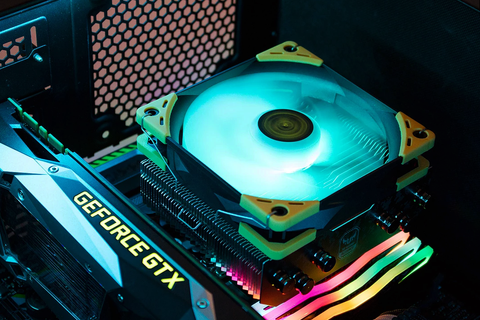Tom's Hardware Verdict
The Scythe Choten TUF Gaming Alliance fits neatly into the budget gaming builder’s toolbox for entry level and mid-tier CPU cooling while providing the aggressive charm of the TUF D.N.A. in a beautiful downdraft cooling tower design.
Pros
- +
Budget friendly
- +
RGB lighting, 4-pin standard
- +
Downdraft design directly cools nearby motherboard components and memory DIMMs
Cons
- -
Cooling performance limited on high-end desktop (HEDT) CPUs and high overclocks
- -
Better suited for dual and quad core processors
- -
RGB Controller is not included
Why you can trust Tom's Hardware
Features and Specifications
Scythe’s second warrior for the TUF Gaming Alliance arena is a villainous-looking, quad-heatpipe cooler utilizing a 120mm RGB PWM fan designated as the Choten. Featuring a compact downdraft design and TUF Gaming Alliance graphics, the $40 (£31) Scythe Choten easily appeals to the budget-centric system builder focused on compact designs and synchronized RGB lighting effects. All of the impressive presentation comes at a price, though, as thermal performance falls behind other coolers of similar size and price.
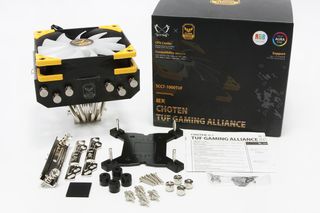
Scythe ships all the standard hardware for mounting the Choten atop nearly all modern AMD and Intel processors, other than Threadripper. Besides the reinforced plastic backing plate, the rest of the cross bracket supports, bracing and machine screw hardware is silver, plated and rather shiny. Best of all, other than the 2-year warranty, is the inclusion of a small packet of thermal compound to expedite installation of the Choten once it lands on your desk, ready for your build.
Specifications
| Height | 4.75 inches / 120.7mm |
| Width | 5.50 inches / 139.7mm |
| Depth | 5.25 inches / 133.4mm |
| Base Height | 2.125 inches / 53.9mm |
| Assy. Offset | 0.5 inches (12.7mm) |
| Cooling Fans | 1x 120 x 25mm RGB |
| Connectors | 1x 4-pin PWM1x 4-pin RGB |
| Weight | 20.25 oz. / 574g |
| Intel Sockets | 775, 115x, 1366, 2011x, 2066 |
| AMD Sockets | FM2(+), FM1, AM2(+), AM3(+), AM4 |
| Warranty | 2 years |
| Price | $40 |
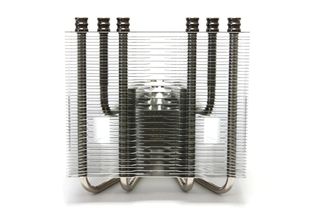
The top-down view of the Choten shows the set of quad-heatpipes as they route through the cooling tower body. While it might look like three, or even six pipes are visible, there are only four in total. The visual puzzle can be accounted for by the inner and outer pairs being offset and of different lengths. The outer heatpipes, being much longer are actually terminated by the chrome caps of the outer and center caps, while the inner pair are much shorter in overall length, yet only the innermost end of the heatpipe terminates with a shiny, silver cap; the other end is hidden, nestled within the cooling fin tower.
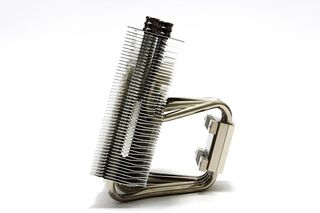
The heatpipes integrate into the mounting base of the Choten which accepts the mounting crossbar for securing the cooler to the mounting braces. The chevron-like side pieces are actually a method of interlocking the cooling tower fins to allow for cutouts which allow torquing of the mounting screws.

The RGB Scythe Kaze fan comes equipped for control via standard 4-pin PWM and RGB headers. The opaque fan blades and hub provides a uniform, glowing effect thanks to the RGB LED lighting contained within, although the Choten does not provide a stand-alone lighting controller, so you’ll need to use a supported RGB capable motherboard or bring your own RGB lighting effects controller.
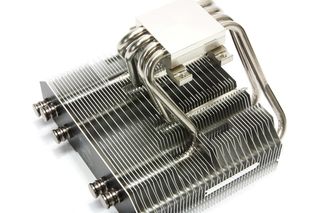
A highly polished mounting base awaits mating to your AMD or Intel CPU of choice. The chevron interlocks show the selection of cooling fins that allow for the access ports between the heatpipes. Speaking of heatpipes, the shorter leg of the hidden inner pair is easily seen tucked away in the center of the cooling tower itself.

DIMM clearance isn't an issue thanks to the Choten's high base clearance. With the heat sink installed, the cooling fan simply snaps into a recess in its cooling fins, and is then secured with wire mounting clips on either side.
MORE: Best CPU Cooling
MORE: How To Choose A CPU Cooler
MORE: All Cooling Content
Image Credit: Tom's Hardware

Garrett Carver is a contributor for Tom’s Hardware, primarily covering thermal compound comparisons and CPU cooling reviews; both air and liquid, including multiple variations of each.
